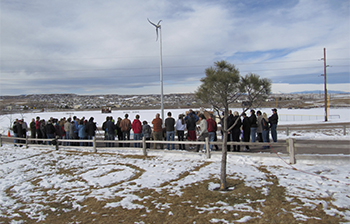 For schools and universities with already limited budgets, developing and implementing significant sustainability measures can seem daunting. While steps such as instituting campus-wide recycling programs, turning off classroom lights and unplugging computers and devices can have a positive impact, schools looking to make more substantial commitments to sustainability on a budget can easily tap into a wealth of free resources and grant- supported programs. From wind turbine funding to energy efficiency software, here are three cost-effective ways to improve school sustainability inside and out.
For schools and universities with already limited budgets, developing and implementing significant sustainability measures can seem daunting. While steps such as instituting campus-wide recycling programs, turning off classroom lights and unplugging computers and devices can have a positive impact, schools looking to make more substantial commitments to sustainability on a budget can easily tap into a wealth of free resources and grant- supported programs. From wind turbine funding to energy efficiency software, here are three cost-effective ways to improve school sustainability inside and out.
1. Integrate Wind Energy
Rural elementary and secondary schools in some states may want to consider participating in the U.S. Department of Energy’s Wind for Schools project. Wind for Schools provides project consultants to help establish small wind turbine installations at rural elementary and secondary schools, and then supports the installation with teacher training and hands-on curricula.
Wind for Schools also has the joint benefit of training higher education students to serve as its project consultants. Balancing education and sustainability, Wind for Schools’ specific goals are to equip college juniors and seniors with an education in wind energy applications; to engage communities in wind energy applications, benefits and challenges; and to introduce both teachers and students to wind energy.
Currently the program is only available to schools in Alaska, Arizona, Colorado, Idaho, Illinois, Kansas, Montana, North Carolina, Nebraska, Pennsylvania, South Dakota and Virginia. However, more than 145 wind turbines — primarily 2.4-kilowatt turbines on 70-foot guyed or 60-foot monopole towers — have already been installed throughout participating states. Participating schools can also monitor kilowatt-hours produced, utility dollars saved and average kilowatt-hours used per month and per year via the Wind for Schools online portal.
More information is available at The U.S. Department of Energy website, www.energy.gov.
2. Join the USGBC — For Free
In September 2015, the USGBC’s Center for Green Schools invited K-12 schools and school districts to take advantage of one free year of membership.
Understanding the unique financial and sustainability challenges and needs faced by K-12 schools and districts, the Center for Green Schools is committed to supporting green school efforts, according to the organization’s website. In addition to all the member benefits associated with a school or district’s USGBC organizational membership, the Center for Green Schools also offers additional support and resources for schools and school districts, including an invitation and scholarship eligibility to the organization’s annual School Sustainability Leaders Summit; complementary registrations and reduced membership rates for the Center for Green School’s Green Classroom Certificate program; access to resources such as the Paid from Savings Guide to Green Existing Buildings, the online Existing Schools Toolkit and regular webcasts for school staff and leadership; eligibility to submit content to be featured on the Center for Green Schools blog; and the Monthly Center for Green Schools digest.
Schools and school districts can sign up for a free year of USGBC membership at www.centerforgreenschools.org.
3. Pick the Right Site
While schools and universities may not have limitless options when it comes to site selection for a new project, renovation or expansion, selecting the right site can result in both long-term cost savings and environmental benefits.
The U.S. Environmental Protection Agency offers a comprehensive, free-to- use school siting guidelines document that helps schools and universities make the best use of often-scarce resources by deciding whether to renovate an existing school, build a new school on a current site, or build a new facility on a new site. It can also guide school and university leaders through decisions related to acquiring land for school facilities, using legacy properties or leasing space; and renovating or reusing existing properties and structures.
The guidelines are specifically intended to help officials make efficient use of energy, avoid costly and dangerous student exposure to pollution and hazardous substances, locate schools near public transportation and potentially design school facilities to double as emergency shelters.
The guidelines outline financial considerations for school siting, such as the cost for mitigating or reducing environmental risks and long-term stewardship of remediation measures. Further, they give specific information regarding high performance and green schools with energy efficiency, water efficiency, indoor air quality, safe materials and reduced environmental impact goals. They also lead officials carefully through the environmental review process, evaluating the impact of air pollution, and a variety of environmental threats such as mold, chemicals, pesticides, polluted soils and historic fill.
The School Siting Guidelines document is available on the EPA website, www.epa.gov.
Learn more in the July/August issue of School Construction News, available soon.

